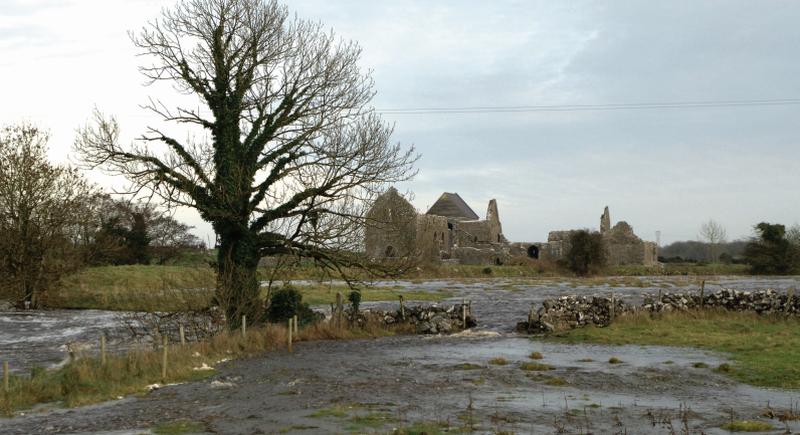Farming
A monsoon in the West

STORM Desmond that raged from last Friday evening through to the early hours of Sunday morning, brought one of the most concentrated periods of rainfall to the West of Ireland since records began.
The rainfall total for the Met Éireann station in Claremorris, South Mayo for the first seven days of December is already at the 131.8mms. mark (5.2 inches) with the vast bulk of that falling in the 36 hour period from Friday night through to late Saturday night.
Farmers and householders across the region have said that the severity of the flooding since last Friday was worse than the last major flood event to hit the region in November 2009.
All rivers across the county have burst their banks with tens of thousands of hectares of land under water – the worst affected areas are the Shannon Callows, the Suck catchment including Ballinalsoe, parts of South Galway, Portumna and the Abbert River catchment area in North Galway.
Desmond – only officially christened by Met. Éireann and the UK Met. Office through the course of Thursday last – left its mark with the amount of rainfall deposited, mostly in the western half of the country.
The trailing tail of the storm was particularly slow moving – stalled by high pressure over continental Europe – leaving a frontal system, containing all the moisture, hanging over Ireland.
Abbeyknockmoy weather man, Brendan Geraghty, collected almost three inches of rain (2.98 or 75.7mms.) from Friday evening last to Sunday morning.
“Over this period of time it was probably one of our most concentrated bursts of rainfall. That is the equivalent of every acre of land being pounded with 300 tonnes of water over that short period of time,” said Brendan Geraghty.
During the last big flood event in November, 2009, Brendan Geraghty, recorded 12.67 inches of rainfall with 4.42 inches of that coming in a three day period from Nov. 17 to 19.
In the November just gone by, the Abbeyknockmoy man recorded 8.18 inches of rainfall (208mms.), making it our wettest month of the year so far.
“The problem with last Saturday’s rainfall was that it had nowhere to go. Land was already saturated, the rivers were swollen and I can never remember the callows of the Abbert River being as flooded before,” said Brendan Geraghty.
If December continues on with its wet trend, then 2015 will turn out to be a very wet year only being ‘saved’ by four dry months – February (2.27 inches, 58mms.), April (2.46 inches, 62mms.), June (1.54 inches, 39mms.) and October (2.26 inches, 57mms.).
For more, read this week’s Connacht Tribune.
Connacht Tribune
Gardaí and IFA issue a joint appeal on summer road safety

GARDAÍ and the IFA have issued a joint appeal to all road users to take extra care as the silage season gets under way across the country.
Silage harvesting started in many parts of Galway last week – and over the coming month, the sight of tractors and trailers on rural roads will be getting far more frequent.
Inspector Conor Madden, who is in charge of Galway Roads Policing, told the Farming Tribune that a bit of extra care and common-sense from all road users would go a long way towards preventing serious collisions on roads this summer.
“One thing I would ask farmers and contractors to consider is to try and get more experienced drivers working for them.
“Tractors have got faster and bigger – and they are also towing heavy loads of silage – so care and experience are a great help in terms of accident prevention,” Inspector Madden told the Farming Tribune.
He said that tractor drivers should always be aware of traffic building up behind them and to pull in and let these vehicles pass, where it was safe to do so.
“By the same token, other road users should always exercise extra care; drive that bit slower; and ‘pull in’ that bit more, when meeting tractors and heavy machinery.
“We all want to see everyone enjoying a safe summer on our roads – that extra bit of care, and consideration for other roads users can make a huge difference,” said Conor Madden.
He also advised motorists and tractor drivers to be acutely aware of pedestrians and cyclists on the roads during the summer season when more people would be out walking and cycling on the roads.
The IFA has also joined in on the road safety appeal with Galway IFA Farm Family and Social Affairs Chair Teresa Roche asking all road users to exercise that extra bit of care and caution.
“We are renewing our annual appeal for motorists to be on the look out for tractors, trailers and other agricultural machinery exiting from fields and farmyards,” she said.
For more, read this week’s Connacht Tribune.
Connacht Tribune Digital Edition App
Download the Connacht Tribune Digital Edition App to access to Galway’s best-selling newspaper.
Click HERE to download it for iPhone and iPad from Apple’s App Store, or HERE to get the Android Version from Google Play.
Or purchase the Digital Edition for PC, Mac or Laptop from Pagesuite HERE.
Get the Connacht Tribune Live app
The Connacht Tribune Live app is the home of everything that is happening in Galway City and county. It’s completely FREE and features all the latest news, sport and information on what’s on in your area. Click HERE to download it for iPhone and iPad from Apple’s App Store, or HERE to get the Android Version from Google Play.
Connacht Tribune
Calls to ‘revisit’ exclusion of sheep sector from Brexit reserve fund

MINISTER for Agriculture, Charlie McConalogue, has been asked to review a decision taken over recent weeks to exclude the sheep farming sector from the Brexit Adjustment Reserve (BAR).
East Galway Independent TD, Seán Canney, has called on the Agriculture Minister and Government to ‘revisit’ the issue of sheep farmers and the BAR fund.
Galway IFA Chair, Stephen Canavan, also said that a mistake had been made in terms of excluding the sheep sector from the BAR funding.
“I think that there is no doubt whatsoever that Brexit had a major impact in terms of New Zealand lamb exports flooding the UK market.
“The knock-on affect of that on Irish sheep farmers was a serious fall-back on lamb and hogget prices through the early months of this year.
“There are now serious concerns that the farmers who buy in store lambs through the early autumn period will just pull out of this market after getting such a scalding over the past six months or so,” said Stephen Canavan.
According to Deputy Seán Canney, all of the Regional Group of TDs are backing the move to get the Government to have another look at the use of the BAR fund for the sheep sector.
“The evidence that sheep farming was affected by Brexit is strong and the decision not to support people in this sector needs to be reversed immediately.
“Brexit negotiations began in June 2016 and caused turmoil in the sheep trade as it weakened the currency making UK lamb far more competitive.
“The notion or threat of ‘a no deal ‘ in Brexit caused the price of sheep to fluctuate repeatedly in the trade and resulted in lambs selling for an estimated €30-€50 lower per head each year during the entire Brexit process,” said Deputy Canney.
Connacht Tribune
Dairy sector driving land market

WITH the exception of Leitrim, Galway was marginally the cheapest county in the west and north-west to buy non-residential farmland during the course of 2022, according to the latest national survey of prices.
The survey showed that the average price of an acre of ‘good land’ in Galway last year, for holdings under 50-acres, was €9,500 – the dearest was Donegal at €12,143 while the cheapest was Leitrim at €6,140 an acre.
Jointly researched by Society of Chartered Surveyors Ireland (SCCI) and Teagasc, the survey also indicated that only 0.5% of land in Ireland goes up for sale each year, a major factor in terms of demand for leased land.
‘Good land’ in Mayo [under 50-acres] averaged out at €10,092; the figure for Roscommon was €9,938; with Sligo coming in at €9,550.
When it came to a comparison of poorer quality land in Connacht [under 50-acres], Mayo was the cheapest at €2,886 followed by Leitrim on €3,300 while Galway topped ‘poor land price league’ at €5,375 per acre.
Auctioneer Martin O’Connor of DNG O’Connor, Oughterard, said that the market was being driven by dairy farmers ‘who are continually ranked throughout the survey as the most likely purchasers of land across the country’.
He said that changes in the European Nitrates Directive in relation to improving water quality meant that many dairy farmers needed more land to comply with this directive.
“In order to maintain current levels of milk production – and to comply with the directive – many dairy farms will need to either increase their land area or reduce milk production.
For more, read this week’s Connacht Tribune.
Connacht Tribune Digital Edition App
Download the Connacht Tribune Digital Edition App to access to Galway’s best-selling newspaper.
Click HERE to download it for iPhone and iPad from Apple’s App Store, or HERE to get the Android Version from Google Play.
Or purchase the Digital Edition for PC, Mac or Laptop from Pagesuite HERE.
Get the Connacht Tribune Live app
The Connacht Tribune Live app is the home of everything that is happening in Galway City and county. It’s completely FREE and features all the latest news, sport and information on what’s on in your area. Click HERE to download it for iPhone and iPad from Apple’s App Store, or HERE to get the Android Version from Google Play.












